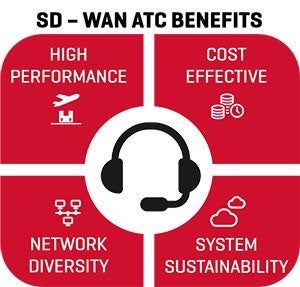Bandwidth demands are growing and network managers are on the lookout for ways to optimize designs, integrate innovative technologies and improve performance for their solutions. As networks grow, technologies must evolve to meet them. In the constantly operating world of Air Traffic Control (ATC), this sentiment is shared as long as it does not jeopardize the safety of the flying public.
Software-Defined Wide Area Network (SD-WAN) has emerged, but is it effective enough to meet these demands? What is all the buzz about? Is it suitable for enhancing air traffic operations?
The solution delivers faster, less complex network performance for a substantially lower price. If traffic is bound for the internet or cloud, SD-WAN can automatically route it to the internet and not tie up costly dedicated circuits. It is made of two core components, a Wide Area Network (WAN) and Software Defined Networking (SDN).
A WAN connects smaller networks to raise performance across the board. They can be geographically diverse and may include devices such as routers, switches, firewalls and modems. In an enterprise environment consisting of multiple WANs, network management is a challenge.

An SDN centralizes and manages a network via predetermined software configurations and is less reliant on costly hardware. It provides an enhanced and intelligent network to quickly route data to end users. Network backlogs can be automatically routed to less crowded paths without human intervention, saving time, money, and improving performance.
When the macro concept of WAN and the agility of SDN marry, the result is SD-WAN, a network that combines the advantages of the hardware and software solutions. Enterprises can route portions of traffic over cost-effective services like broadband and can automatically re-route traffic as needed.
SD-WAN deploys in a combination of hardware and software configurations to be agile. This allows governing security and application policies to be centrally managed for real-time updates as network requirements change. It can also be considered in situations where more mission critical solutions are needed.
This allows information to reach its destination securely and directs communications to more secure network paths like dedicated optical wavelengths. It furnishes additional data with network encryption which ensures safe delivery.
Meeting network demands can be simplified with developing technologies like SD-WAN. When considering it as a potential technology to improve performance or bandwidth for an industry like aviation, ask the following questions:
Is the network geographically diverse?
Is the information being sent through the network mission critical?
Is cloud computing an option?
SD-WAN solutions, if designed properly, accomplish these things in multiple ways and through multiple working concepts. It is a practical and useful application that seamlessly integrates into an already existing network, but only if the systems integrator has the necessary domain expertise to assign which services take priority. SD-WAN can be cost effective, efficient and scalable when applied to the right mission.
That is what the buzz is all about.
